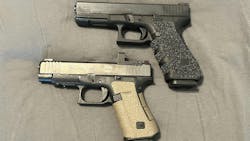Different Police Professionals Have Different Firearm Considerations
What to Know
- Adjustable stocks and interchangeable grips allow officers of varying sizes to handle firearms more effectively.
- Switching to firearms with different magazine capacities and grip sizes can accommodate individual needs without sacrificing functionality.
- Training remains consistent across striker-fired handguns, but proper fit is crucial for quick, accurate responses under stress.
More on OFFICER.com
Download the July/August issue of OFFICER Magazine.
Click Here to subscribe to OFFICER Magazine.
What would you do if you were the Chief of Police or Sheriff for a given county and your county council approved your budget on ONE condition: Every officer, no matter gender, height, weight, etc., had to wear the same uniform? We don’t mean the same colors, etc. We mean, you were told you had to buy the same size of everything and issue it and the officers had to “make do” with what they were issued. That’s entirely impractical and unrealistic, right? Then why, in today’s world with so many options available, do we issue one handgun make, model and caliber and expect every officer, no matter their size, to use it proficiently?
If you have enough experience with firearms, especially handguns, you are aware that not every handgun serves everyone equally. It’s likely that if you’ve been asked, “What kind of gun should I get for self-defense?” by friends, you’ve not answered with a specific make, model or caliber, but instead with some guidelines on what the person needs to know to make an appropriate selection. There’s no reason, other than simplified logistics, that the same can’t be done with department/ agency issued handguns.
Before we get deep into handgun considerations and possibilities, some of you might be wondering, “What about patrol rifles?” The answer is easy: adjustable shoulder stocks are so common that the length of pull, from rear of stock to front of trigger, can be adjusted to fit most if not all officers on the street today. If your agency is issuing patrol rifles with fixed stocks, spend the money to replace them, even if just some every budget cycle, with the adjustable stocks. It will almost certainly result in a measurable increase in your officers’ qualification scores and weapon comfort.
Now, back to the handguns. Every year OFFICER Media Group executes a State of the Industry Survey in which we ask about duty handguns: make and caliber and any intended changes in either. Our last survey results showed that Glock, Sig Sauer, Smith & Wesson and FN America were the four main manufacturers finding their way into law enforcement holsters. 9mm is still the most popular caliber carried and many who had been carrying the .40S&W cartridge are switching back to 9mm, although some are switching up to .45ACP.
Most firearms instructors will tell you that the training curve from one handgun to another handgun, provided they have the same function, i.e. striker fired, isn’t great. It takes some shooting for an officer to get familiar with the feel of the new gun and how it fits the hand, but from recognition of a threat to draw/presentation to acquiring a sight picture and performing a proper trigger press is pretty much the same. That changes if you change functionality, say from a double-action/single-action handgun to a striker fired handgun, but the large bulk of duty weapons today are striker fired. So then the question is why would you force a five-foot-tall officer with small hands to wear, carry and qualify with the same handgun as your six-foot-four-inch tall officer who has much larger hands?
“Mounting” the handgun properly matters and when drawn with the master grip, the shooter’s forearm bones should be in alignment with the center line of the barrel. In other words, the barrel should appear to be an extension of the forearm skeletal structure. If the shooter’s hands are too small for the grip and the weapon has to be turned to reach the trigger, then the barrel is out of alignment and the shooter will inevitably have a harder time qualifying and/or shooting accurately under stress.
But such a challenge is unnecessary and easily avoided, although it takes a greater logistical effort, perhaps a few more budget dollars and a quartermaster staff that understands how a handgun should fit the shooter’s hand. A while back, the U.S. Park Police issued the H&K P7 handgun. That gun came in two configurations: The M8 and the M13. The M8 held 8 rounds per magazine of 9mm and the M13 held 13 rounds per magazine. The functionality was identical, but the grip circumference was different because of the size of a single stack magazine as compared to a double stack magazine. The same could be done today with a variety of handguns from several different manufacturers. The easiest one to use as an example is Glock.
Many agencies have issued the Glock 17 9mm. Many larger agencies also issue the Glock 19 9mm which holds two less rounds per magazine but has the same grip circumference, just a shorter overall length of the grip frame. Some agencies just purchased and issued the Glock 19 to all officers because the 17-round magazines could still be used for reloads, but with 15+1 already in the Glock 19, were the extra 2 rounds really necessary? The reality is that for some shooters with small hands, the grip circumference of the Glock 17 or 19 is just too big. Glock resolved some of that with a slimmer grip frame and interchangeable backstraps, thereby making the grip “custom fit” for each shooter. Even then, some hands were too small. Is there a solution? Yes, but it takes either some extra spending OR it requires acceptance of fewer rounds in the gun.
The Glock 48 is slimmer than the Glock 19 overall but otherwise the same dimensions. It also only holds 10-rounds per magazine in its stock configuration. If the agency/shooter is willing to give up the five rounds per magazine, then switching from the Glock 19 to the Glock 48 is an easy fix to making the gun more comfortable for those with smaller hands. Functionality is identical so retraining wouldn’t be necessary. If the five rounds per magazine are considered mandatory, there are after market kits that provide 15-round magazines, requiring the magazine catch to be changed out by the agency armorer.
If the U.S. Park Police could accept 8- and 13-round capacities dependent on hand size, and the attached weapon manageability, wouldn’t the same be acceptable between 10- and 15-round capacities? Fitting the weapon to the shooter should be considered mandatory and budget or policy adjusted to support such.
About the Author
Lt. Frank Borelli (ret), Editorial Director
Editorial Director
Lt. Frank Borelli is the Editorial Director for the Officer Media Group. Frank brings 20+ years of writing and editing experience in addition to 40 years of law enforcement operations, administration and training experience to the team.
Frank has had numerous books published which are available on Amazon.com, BarnesAndNoble.com, and other major retail outlets.
If you have any comments or questions, you can contact him via email at [email protected].

